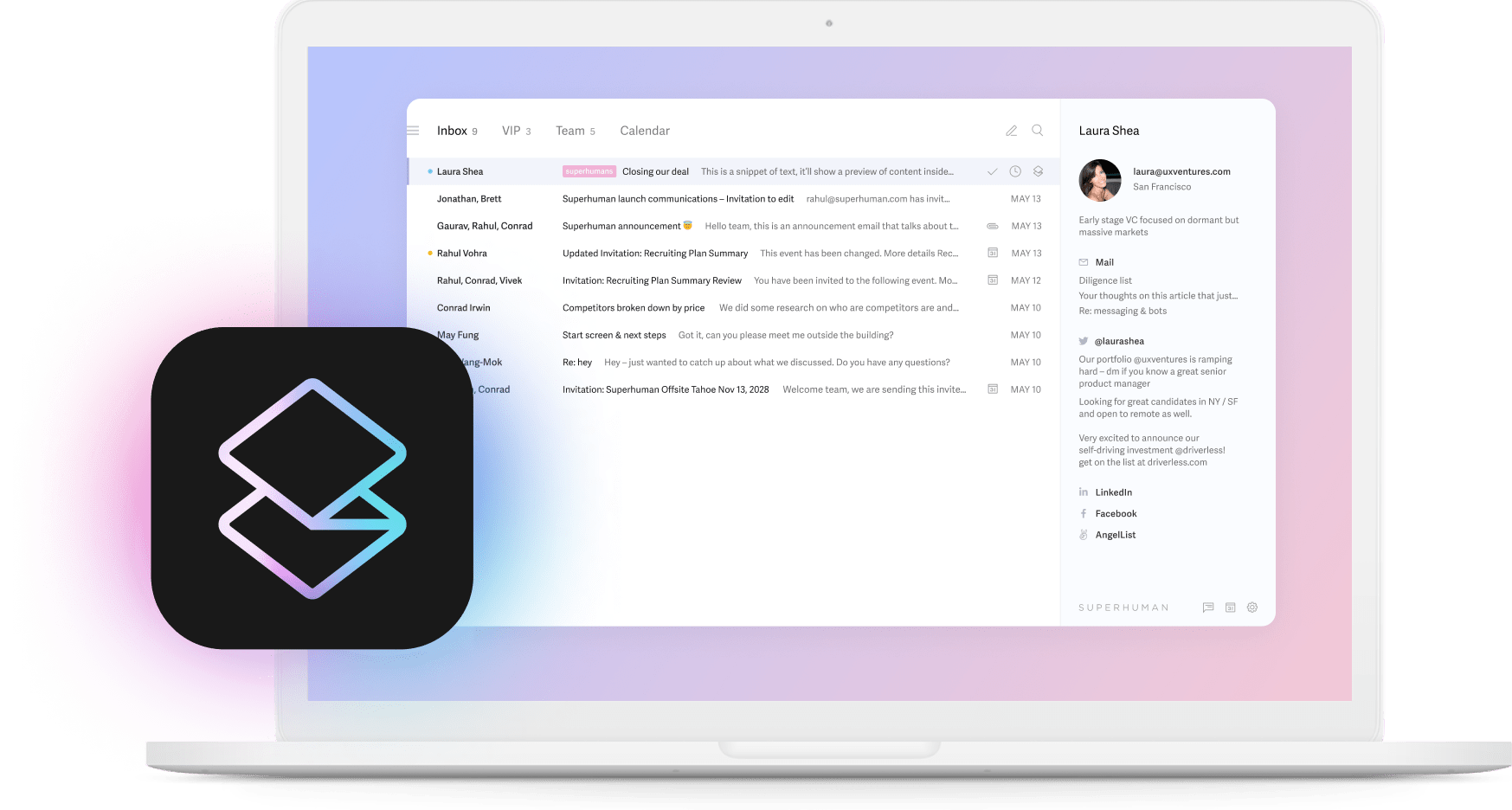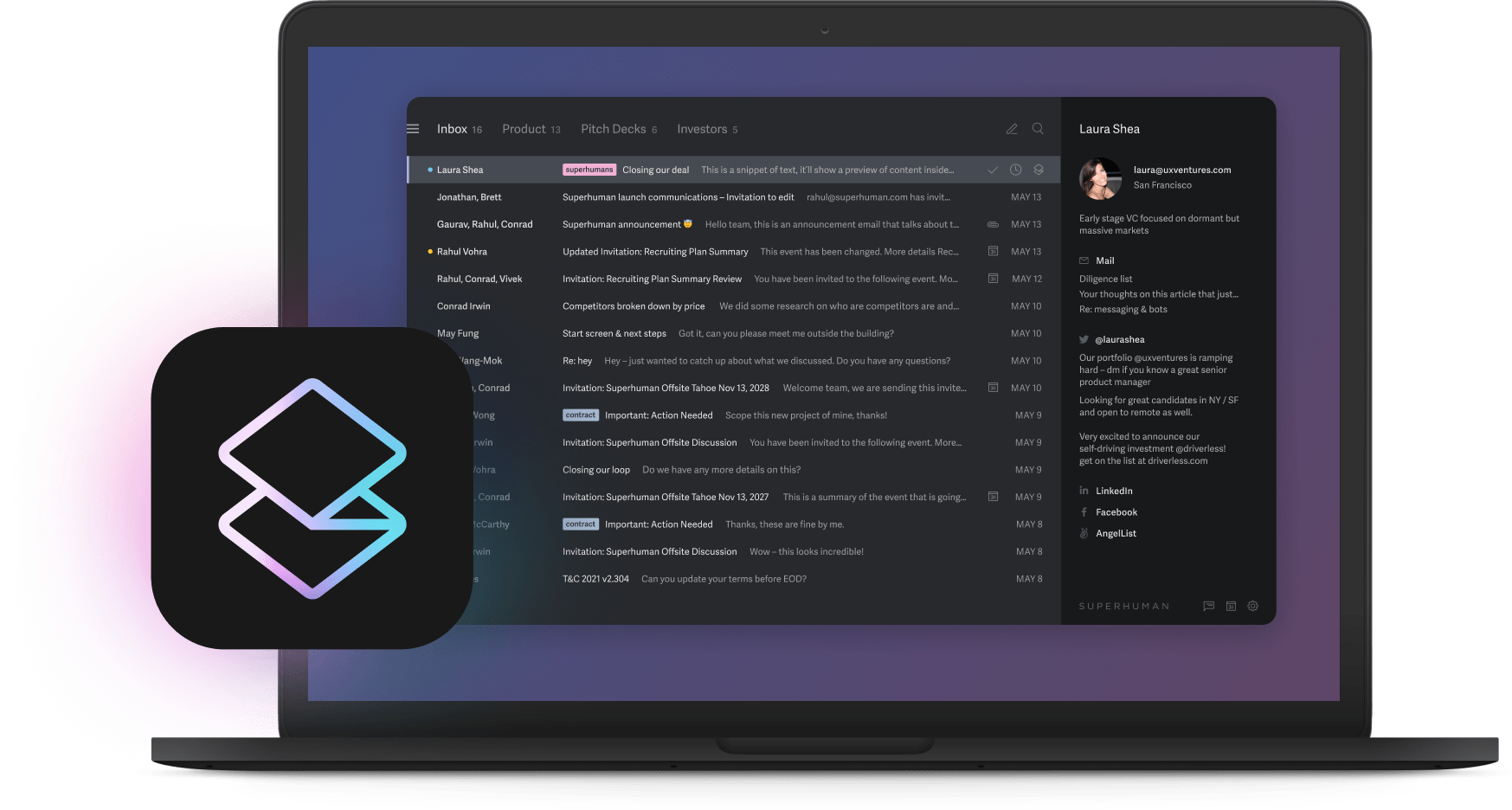
Customer retention is relevant for every type of business.
The internet is full of guides with catch-all tips and strategies to help you retain loyal customers over time. Most guides offer great strategies, but they don't all tell you why they work. And sometimes, you need more than customer retention best practices. You want to see a particular strategy in action!
At Superhuman, we cultivate customer retention by building a product our customers love. But that's not the only way we retain customers. While a great product is the key to customer retention, our Delight team is also a crucial part of our strategy to keep as many long-term customers as possible.
Want to learn some of the behind-the-scenes secrets about how the Superhuman Delight team approaches customer retention? Read on…
What is customer retention?
Customer retention measures a company's ability to turn buyers, users, or customers into repeat customers, while preventing them from switching to a competitor. It's affected by how many new customers you gain, and how many current customers churn (more on that below!). A business's customer retention rate is often expressed as a percentage of its total customers over a given time period.
S = number of customers at the start of a given time period
E = number of customers at the end of the same time period
N = number of new customers added during that time period
Customer retention rate = ((E-N) / S) * 100
Here's an example. Say you started the first quarter of 2022 with 20 customers. At the end of the quarter, you had gained five new customers, and had one customer churn. In this case,
S = 20
E = 24
N = 5
Your retention rate = ((24 - 5) / 20 * 100 or 95%. In most industries, that would be considered pretty great!
Your customer retention rate can be a good indicator of customers' satisfaction with your product or service, especially if you measure it and find that you have good customer retention over longer periods of time. As you calculate your retention rate at different times, you can start to look for patterns and similarities that can point your customer success team toward strategies to increase retention and prevent churn.
Read more: 14 customer retention strategies
Why is customer retention important?
Over and over, studies show that it costs businesses less to retain their existing customers than to acquire new ones.
Acquiring a new customer can cost up to seven times more than holding onto existing customers. Increasing customer retention by just 5% can increase profits by up to 95%. Selling a new product or service to an existing, already-satisfied customer has a success rate of 60-70%, compared to just 5-20% when selling to a brand new customer.
Customer loyalty doesn't just mean you get that customer's business. In addition to staying with your company long-term, a happy customer base is more likely to spread the word about you and your products, creating free word-of-mouth promoter marketing to family and friends. These kinds of unofficial brand ambassadors can become a great source of referrals, in addition to their own repeat business.
Bonus retention tactic: collect testimonials from your happiest customers to serve as social proof on your website or popular review sites. We built out an entire Wall of Love!
How do you measure customer retention?
We've already covered how to calculate your customer retention rate, but that's not the only key metric related to customer retention. If one of your business goals is to increase customer retention, there are some other important benchmarks and KPIs to keep an eye on…
- Customer acquisition rate. This measures how many new customers you gain in a given period of time. Customers are going to churn — there's no way to completely avoid it — so acquiring new customers is necessary to maintain high customer retention.
- Customer churn rate. This measures how many customers leave in a given period of time. While some churn is expected and unavoidable, regularly high churn rates could indicate that your product or service (or customer experience) isn't living up to customer expectations.
- Customer lifetime value. This customer retention metric shows how much revenue you can expect to gain from a single customer over their entire lifecycle with your business.
Bonus retention tactic: a customer loyalty program can help incentivize customers to stay with you long-term, boosting their lifetime value!
5 customer retention strategies from Superhuman's Delight team
At Superhuman, our Delight team exists to, well, delight Superhuman customers.


They collect customer feedback so that Superhuman's Product team can build products that our customers truly want! They offer support, build customer relationships, and so much more, all to ensure that every Superhuman customer gets the greatest possible value out of their experience… and saves as many hours as possible.
In communications with customers, the Delight team follows five key principles:
- Positivity: Be upbeat, enthusiastic, and optimistic. Judiciously use emoji 👍 and exclamations!
- Gratitude: Be genuinely thankful for the time people spend interacting with us.
- Insight: See beyond the basic communication, and treat every interaction as a way to learn what people really want.
- Quality: Be clear and concise, and avoid typos, inaccuracies, and inconsistencies.
- Service: Treat every customer like a VIP. Focus on doing the best job possible for them.
Below, we'll explore each of these in more detail for a closer look at how Superhuman builds impactful, lasting relationships with customers through these principles.
1. Positivity
There's a fascinating phenomenon that's important to note about customer behavior: written communication, from social media to email, lacks the facial expressions, physical gestures, and vocal tone that typically shape our interpretation of what someone is saying. Because of that, people tend to assume the worst. In other words, an email with a neutral tone will come across as negative. An email with a positive tone is likely to come across as neutral!
That's why positivity is the first of the Delight team's five principles — all of our written communication is upbeat to overcome that negativity bias and leave customers feeling positive about their interaction.
Emoji and exclamations function as a shorthand for the social cues that emails usually miss, conveying that you are enthusiastic and supportive, without requiring you to be overly wordy. This makes positive intentions more clear, increasing the odds that the message is well-received and the customer is delighted!
In addition to combating negativity bias, the Delight team strives to build a rapport with customers over time. This increases customer engagement and satisfaction, since they always feel like they can look forward to friendly and helpful communication with the Superhuman team.
2. Gratitude
Another important principle the Delight team follows is that customer feedback is something we're tremendously lucky to receive! No matter what type of feedback is it, it's vital to always express gratitude to the customer for sharing their feedback — it's how we build a great experience for them, after all.
But we take feedback even a step further than that. Part of showing gratitude for customer feedback is making it actionable whenever possible, so we categorize every piece of feedback we receive — big or small — and use customers' very words to inspire and inform what the Product team thinks about building next!
3. Insight
An important part of providing customer support that delights is truly understanding what the customer is struggling with or asking for. This can be tricky, especially when customers email you the first time with a vague ask. When this happens, the delightful thing to do is to get to the bottom of the customer's needs as quickly as possible, minimizing back-and-forth, but with a follow-up when it's truly needed.
Here's an example:
Customer: Seems like replying all to an earlier message in a thread (when you have different recipients later on) is broken on mobile (iOS) — I just tried this earlier and it would not let me.
Good: Please can you share the steps, or maybe a video of what isn’t working :)?
Better: If you hold your finger on a message for 1 second, we reveal a "more actions" pop-up. You can use that pop-up to reply to the message. Is that working for you, or is something about that not working? If so, I’d love to understand better what isn’t working, so we can help out!
Even better: If I understand correctly, you're trying to [do a thing]. [If so, instructions]. [If not, ask for steps to reproduce the problem]
4. Quality
An important part of Quality for the Delight team is always being as close as possible to 100% sure that instructions given to a customer are going to work.
Why? It's delightful to receive detailed, high-quality instructions that work! For example, if a customer is having an issue, never ask them to quit and restart the app unless you know it will solve their problem.
It's also important to be as precise and detailed as possible, using screenshots and other images to help convey information whenever it will help.
For example…
- It's good to say: our "Other" tab encompasses Gmail's Promotions, Forums, etc.
- But it's excellent to say: our "Other" split is a simplification of Gmail's Promotions, Forums, Socials and Updates categories. We also pull Google Docs emails out and put them in our "Important" split.
See how the second explanation is so much more precise, using the correct language ("split" to describe Superhuman's Split Inbox feature, "categories" to describe Gmail's feature)? That makes the response much higher quality and increases the odds that the customer will know immediately upon reading what the message is referring to.
5. Service
The final principle is service, and this one is pretty straightforward: be polite, helpful, and accountable, to provide customers with the best possible service experience.
Throughout the entire customer journey, from onboarding onward, customers can expect friendly, helpful interactions with our Delight team. It's one of the things we're known for!
These are some of the ideals that guide our Service principle:
- Always say please when making an ask of a customer.
- Take responsibility if someone complains about Superhuman.
- Use customer terms, not corporate terms. For example, instead of saying "I've relayed this to our engineering team", say, "I've taken a note and we'll let you know when this is fixed :)".
- Make "I" statements, instead of "we" statements. It makes interactions feel more personal. For example, "I appreciate your feedback" instead of "we appreciate this feedback".
- End emails in a way that encourages more communication, if needed. For example, don't say "Hope this helps". What if it doesn't help? Instead, try a more open-ended closing like, "Did this help?" or "Please let me know if this helps :)".
Delighting customers all starts with the best communication
There you have it — some of the behind-the-scenes secrets that help Superhuman create delight for every customer. Businesses from ecommerce to brick-and-mortar can adopt and adapt these principles for their own customer retention programs.
But the bottom line is this: customer retention starts and ends with clear, transparent, helpful communication.
Communication is a key piece of any business's retention strategy. That's why you should give your own team the best possible tools to make their inbox faster, more productive, and more powerful. Try Superhuman today.




